- Home
- Deborah Blum
The Ghost Hunters Page 13
The Ghost Hunters Read online
Page 13
They also refused to accept that the Hodgson-managed seances weren’t real events. Davey was too good; he must be a renegade medium, maliciously seeking to discredit his own profession. Even Alfred Russel Wallace was drawn into the fight, taking the side of the spiritualists and making it obvious how far he had drifted from the Darwinian mainstream for the moment. “Unless all can be explained,” Wallace declared in late 1885, “many of us will be confirmed in our belief that Mr. Davey was really a medium as well as a conjurer, and that in imputing all his performances to ‘trick’ he [Davey] was deceiving the Society and the public.”
ACROSS THAT INTRACTABLE ATLANTIC, the psychical researchers suffered through no such dramas, but then, their best work was being done in careful secrecy. Afraid that he was somehow being gulled, James had asked the Reverend Minot Savage, his partner in other medium investigations, to take his own look at Leonora Piper.
Savage paid an anonymous visit to Mrs. Piper, telling her only that he’d heard of her trances and wished to observe one. At Savage’s first sitting, Mrs. Piper talked about his father, who had died years before in Maine. “He calls you Judson,” she said. Judson was Savage’s middle name. Only his father and his half-brother, also dead, had ever called him that.
Savage wrote up a detailed, somewhat incredulous description of the sitting: “She went on to say, ‘Here is somebody else besides your father. It is your brother, no, your half-brother, and he says his name is John.”’ Savage noted that his half-brother’s name was John, which was not an uncommon name and could easily have been guessed. That wasn’t the part that shocked him. It was what came next, the way Mrs. Piper went on to describe with painful accuracy, partly in pantomime and partly by speech, the method of his half-brother’s death. She finishing by saying, “When he was dying, how he did want to see his mother.”
Savage’s half-brother had never lived in Boston. He had died in Michigan, two years earlier, “in precisely the way the medium had described the facts.” John was a “mother’s boy,” Savage said; he’d died calling out to her. Aside from the details, the way Mrs. Piper talked in trance, as if these dead people were somehow sitting beside her, was unnerving, to say the least. Still, both Savage and James had learned that trusting any medium was a risky business. Perhaps Mrs. Piper had some kind of detective bureau at her service; perhaps she’d somehow discovered both men’s extended family history. Savage decided to give her a test that even the best spy network would find hard to beat, a complicated, multilayered kind of experiment.
To start, Savage told his daughter to visit Mrs. Piper, using an assumed name. His daughter asked a friend to write the letter seeking the appointment, so that not even the handwriting would be a clue. Another friend then provided three locks of hair, placed in a book—front, middle, and back—so as to keep them separate. Savage’s daughter knew nothing about where the hair had come from, or even whether the donors were still alive.
As she told her father, she hoped the visit wouldn’t be too ridiculous. Beyond that, she was keeping her expectations low.
Minot Savage wanted more than just to present Mrs. Piper with a tricky test. He also wanted to evaluate a concept that currently intrigued psychical researchers. Called “psychometry,” it was the idea that material objects could convey information to people, or conversely, that some people had the ability to read information from rocks and wood, paper and metal.
The word psychometry had been coined in 1842 from the Greek words psyche, “soul,” and metron, “measure.” But the idea itself was woven through folklore from many cultures and many, many years past. Generations of ghost stories derived from the belief that a building could contain memories of a murder, that terror could inhabit a place for years to come.
Most academics regarded the idea as so rank with superstition that it was hardly worth discussing. About thirty years earlier, though, a Boston geologist had decided to run psychometry tests on his wire—who claimed some psychic ability-and a few of her friends. His experimental approach was simple in the extreme, using the materials he knew best. The geologist wrapped rocks in paper packets and asked the sensitives to tell him something about the contents. A fragment of lava from the Hawaiian volcano Kilauea elicited the response, “It seems as if an ocean of fire were pouring over a precipice”; a limestone pebble with glacial scratches: “I am going, going, and there is something above and around me. It must be ice. I am frozen in it.”
As critics pointed out, his test subjects could have been guessing while they tried to feel the rock through paper. And even if there was something to psychometry, no one could explain how an inanimate object could communicate with a person. The concept provoked questions rather than theories: Was there an energy left by intense events? Could a house somehow retain the “memory” of a violent murder; could a rock recollect the savagery of an eruption? Or was it all just a fascinating dream of supernatural abilities, kept alive by the occasional coincidence?
Savage didn’t know himself. But he did know that Leonora Piper had shown a possible psychometric talent in that Italian letter test given her by Margaret Gibbens. It was that which led him to devise the experiment with the locks of hair. Like his daughter, he kept his expectations as low as possible—which meant that both of them were shocked by the outcome.
As Savage wrote in his report to the ASPR, “After Mrs. Piper had gone into a trance, these locks of hair were placed in her hand, one after another. She told all about them, gave the names, the name of the friend who had asked her to bring them, and even asked why one person had cut the hair from the end, where it was lifeless, instead of nearer the head.
“My daughter, of course, did not know whether any of the names given or statements made were correct or not. She made notes, however, and found that Mrs. Piper had been accurate in every particular.” James and Savage collaborated on a formal report to the American society, which admitted that both men found Mrs. Piper inexplicable. They urged that the ASPR invest serious time and money investigating all the questions they had raised about the medium. Here, they said, was a rare opportunity to put “real” science to work, and they hoped not to lose it.
5
INFINITE RATIONALITY
SUDDENLY, in a shock of glorious insight, Edmund Gurney realized the truth about immortality. The moment was breathtaking, luminous. He alone had solved the infinite puzzle, seen the path to eternal life.
Unfortunately, as he complained to William James, that gleaming certainty melted like ice in a thaw—about the time the nitrous oxide he’d received at the dentist’s office wore off. “I was only waiting for breath & energy to inform the lucky dentist, when it somehow lapsed.” Still, even leaving the office, Gurney had felt sure that he could write a brilliant journal article. By the time he got home, the brilliance had worn off, but Gurney still thought he might write James a letter filled with useful insights. “Then the evening came & somehow the letter did not seem as if it would have much in it and didn’t get written.”
Oh, those transient moments of narcotic genius. He’d had them before; he suspected he’d have them again, given his particular habits. Gurney suffered from occasional bouts of neuralgia, sharp bursts of pain exploding along the nerves in his face. He’d taken to relieving the pain by inhaling chloroform or, during particularly miserable episodes, laudanum, a solution of opium and alcohol.
There was no stigma to it; self-medication was a stylish fact of the times, prescribed by doctors, practiced by the educated and the wealthy. William James also used chloroform to treat neuralgia, and he had once published an essay on the fleeting brilliance of nitrous oxide inhalation. Fred Myers and Dick Hodgson had both experimented with hashish, although Myers had simply fallen asleep, and Hodgson had disliked the giddy loss of control : “I’m not born to be hashish’d out of my organism.” Doctors widely prescribed laudanum for pain, stress, depression, and menstrual symptoms. In Europe, medical researchers experimented with cocaine as a therapeutic agent. In 1884 a young Austrian psych
iatrist, Sigmund Freud, had published a well-received research paper, “On Cocaine,” based partly on his own use of the drug as a stimulant and counterdepressant.
Insights imparted by narcotics, as James had ruefully written, always proved mere illusion—even if one could remember them. Once he carefully jotted down every thought that occurred to him under the influence of nitrous oxide. In the morning he had pages with single words written over and over—God, day, night, prayer—scribblings that “to the sober reader seem meaningless drivel but which, at the moment of transcribing, were fused in the fire of infinite rationality.”
Consistently, sadly, by the dry light of morning, by the time one returned from the dentist, there was nothing left but a tantalizing memory, ashes with not a phoenix in sight. Gurney regretted those ashes. If only there were such a fire that burned longer, with the sustained light to illuminate the hidden promise of his project.
GURNEY AND MYERS were building their studies of the everyday occult into a book. They’d given it the title Phantasms of the Living as a way of describing the supernatural events that they deemed credible—that 5 percent of all reports Gurney had mentioned to James. They wanted both to recount those stories and to put them in perspective, reinforcing their “evidence” with theories that might explain it and arguments to support those theories. They wanted the book to be so good, so compelling, that it would sway the world.
The intensity of that desire, the demands of the project, were so overwhelming that they’d recruited a third collaborator, thirty-year-old Oxford graduate Frank Podmore. Thin, perfectionistic, ever serious in outlook, Podmore had won honors in both classics and natural science at Oxford with his meticulous scholarship. He now supported himself as a postal inspector, which left him time for other interests. And he boasted a Hodgson-like flair for investigation that Gurney thought could only strengthen the evidence they would accumulate. The only problem was in making sure that Podmore and Myers didn’t quarrel throughout the entire project.
The two men—one obsessed with details, the other’s eyes on the philosophical horizon—had been at odds almost since the work began. It wasn’t just the book, although that most concerned Gurney at the moment. Sidgwick had also asked Podmore and Myers to investigate the mystery-cloaked life of Daniel Dunglas Home. They were arguing over that as well.
The reclusive psychic Home had finally lost his long battle with tuberculosis. At fifty-three years of age, he had died in southern France on June 21, 1886. His Russian wife buried him in a Paris cemetery under a tombstone inscribed simply, cryptically, “To another discerning of Spirits.”
Home’s career still haunted the field of spiritualism. As Podmore would write, most professional mediums were “imposters of a sufficiently common place type,” easy to catch in fraud and chicanery. The Davenport Brothers, Anna Eva Fay, Henry Slade, Florence Cook—to name a few on a very long list—all had been exposed with very little effort.
No one could say that of Home. There were whispers of exposures at private sittings, but never a public unmasking. His cheats, if that is what they had been, went undetected. Even Robert Browning, who had so deftly skewered Home as “Mr. Sludge,” confessed to Myers and Podmore that he had never been able to catch Home in fraud. Browning only wished, as so many other critics had done, that he had been so lucky. As Podmore wrote, “commonplace is the last epithet that could be justly applied to Daniel Dunglas Home.”
Like many before them, Myers and Podmore could not agree on how to define D. D. Home. Myers was inclined to consider Home a rare talent, a medium with unusual gifts for tapping into occult forces. Podmore was inclined to consider him an unusually deft conjurer, one of the greatest hypnotists of his time, or some combination of the two.
If Home could induce mass hallucinations, that might explain some of his more improbable effects—floating out a third-floor window into the London night, summoning shadows into shapes, elongating his body so that he appeared to stretch as thinly as a bit of India rubber. “Probably some of the more marvelous feats described at Home’s seances can be analyzed into sensory deceptions of this nature,” Podmore would eventually conclude.
Hypnosis would not serve to explain the carefully catalogued experiments that William Crookes had conducted. Podmore could only speculate that in such cases Home cheated, and that scientific procedures were insufficient to detect such a sophisticated manipulator at work. But that left the depressing conclusion that one unusually deft medium could easily outwit some of the best scientists of the day. “In Home and his doings all the problems of spiritualism are posed in their acutest form,” Podmore would write ruefully. “With the marvels wrought through him or by him the main defenses of Spiritualism must stand or fall.”
Meanwhile, Phantasms of the Living was nearing completion. The authors and their friends debated every aspect of it, including the title, which seemed adequate rather than engaging. Still, they couldn’t decide on a better one, and “phantasm,” meaning illusion or hallucination, seemed an objective way to describe what Gurney, Myers, and Podmore had collected: reports of phantoms and ghostly voices, premonitions and warning dreams, flickers of connection between the living and the dead, and the implications of what lay behind them.
It was the implications that worried Henry Sidgwick, or at least, how to present those controversial ideas. The plan had been for Myers and Gurney to share equal billing as lead authors. But Sidgwick began to think that a poor decision. True, Myers was the more graceful, more literary writer. But Gurney wrote with more simplicity and thus greater clarity. More important, Sidgwick admired Gurney’s methodical approach; he was less easily carried away by an idea than was Myers. Given the hostility simmering around them—from scientists and now spiritualists—Sidgwick suspected that one strong voice rather than “two heads on one neck” would best serve the project. He wanted Gurney’s level head to represent the project. The sensitive Myers, however, would need careful handling.
Sidgwick set the stage over dinner. For the discussion after the repast, he made sure that a soothing fire warmed his library, which he stocked with plenty of good brandy. As the snifters drained, Sidgwick proposed that they turn the book over to the more cautious Gurney. To his diary, Sidgwick admitted it had probably been a lost cause from the beginning. Even the finest brandy could not prevent Myers from seeing what was afoot. “I was palpably aiming at ousting F.M. and leaving E.G. sole author; estimating the superior trustworthiness of the one in scientific reasoning more important than [the other’s] literary superiority.”
Other people might underestimate Sidgwick, mistake his gentleness for passivity. His friends knew that he was relentlessly stubborn. When the evening was done, Sidgwick had worn his colleagues to a compromise. Myers would write the introduction, and Gurney the bulk of the book. “I could tell that M. was annoyed but he handled it admirably.”
Not entirely admirably. Some of Myers’s frustrations and resentments spilled into his writing, which took on a sharp, challenging tone. The provocative question that he chose to confront first was that of proof: In a modern age, Myers asked, could religion endure based on faith alone? Could any God—Christian or otherwise—survive in an age where religion feared science and science denied faith?
It was into that divide that Myers saw psychical research bravely marching. The goal was to bridge research and religion, to show that they were not incompatible, that one could even help explain the other. Yet there was as much peril as promise in such an effort. Orthodox science might contradict religious dogma, as Darwinian theory had appeared to do, but its proponents had in general—aside from a few aggressive hard-liners such as Tyndall—left matters of the spirit to those who professed to understand such things. The faithful could dismiss theological contradictions. They could declare evolution and natural selection irrelevant to the contemplation of God and His powers. Those who didn’t like the conclusions of geologists, biologists, and physicists could ignore, dismiss, even ridicule.
Psychical re
search, however, explored the very mysteries that other scientists had, thus far, eschewed, and that the faithful reserved as their own. If a fossil were erroneously identified, a rock poorly dated, scientists could be embarrassed, shamed, forced to make corrections. But the error posed no threat to theology. If research failed entirely in its goals, Myers said, if chemistry and physics and astronomy all together stumbled, the faithful would in no way suffer. But if he and his colleagues failed, if they could find no evidence of an afterlife, no proof of otherworldly powers, they might further undermine the church’s promises of immortality. And there, indeed, was the risk: he and his friends might find the evidence for “the independence of man’s spiritual nature and its persistence after death”—or they might confirm the existence of nothing, no promise beyond that of a quiet grave.
If dedicated psychical researchers could detect no flicker of noncorporeal spirit out there in the universe, then the final result, Myers thought, would be to prove Tyndall and his allies right. Perhaps the truth was that religion couldn’t stand up to science. Perhaps all the belief systems—from Christianity to Hinduism—existed only because they had been created in a time before scientific challenge.
The very argument gave Sidgwick the willies. The traditional churches had not rallied to psychical research; clergymen tended to point out disdainfully that the immortality promised in the Bible in no way resembled the spooks and specters of SPR investigations. Sidgwick had hopes that, with time, the churches would alter that stance, accept that miracles needed evidence, that science and faith could stand together in the pulpit. He worried that Myers’s confrontational position might be so alienating as to make such discussions impossible. He feared his colleague’s forthrightness would further isolate their cause.

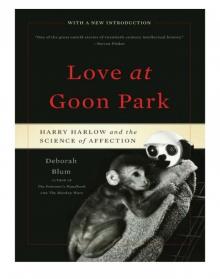 Love at Goon Park: Harry Harlow and the Science of Affection
Love at Goon Park: Harry Harlow and the Science of Affection The Poison Squad
The Poison Squad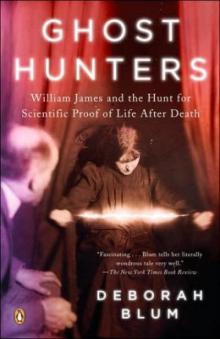 Ghost Hunters: The Victorians and the Hunt for Proof of Life After Death
Ghost Hunters: The Victorians and the Hunt for Proof of Life After Death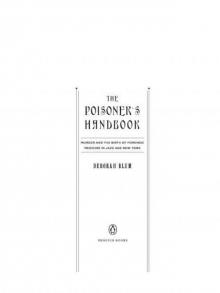 The Poisoner's Handbook
The Poisoner's Handbook Angel Killer
Angel Killer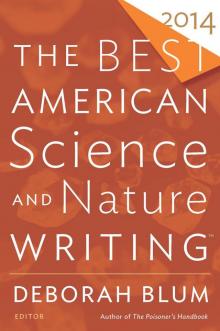 The Best American Science and Nature Writing 2014
The Best American Science and Nature Writing 2014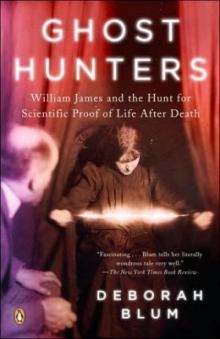 The Ghost Hunters
The Ghost Hunters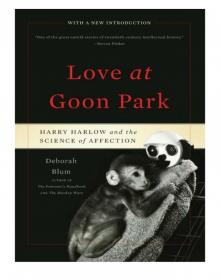 Love at Goon Park
Love at Goon Park